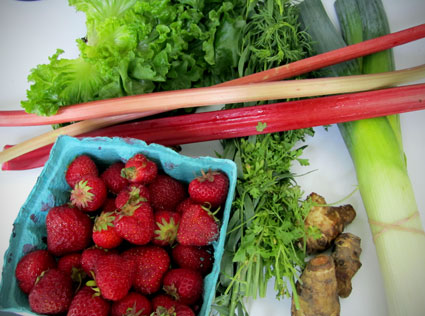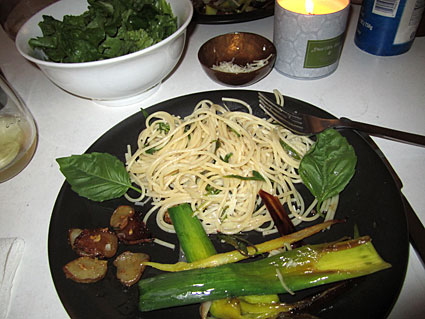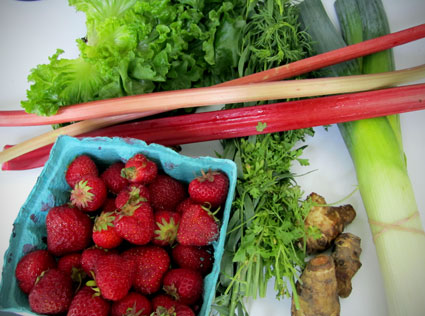I’ve lived in New York for four years. Being a busy, free spirit in the city doesn’t lend itself to grocery shopping and meal planning. So, like many New Yorkers, I enjoyed living off the fat of the land. And by that I mean the takeout menu. Like many of my peers on the takeout diet, I was spending way too much money and getting a little puffy around the edges. Containers lay strewn about my apartment. Which is how I learned my sweet pad-thai containers don’t biodegrade. OK, so I didn’t learn it that way. But it is true. They don’t. Oh, the guilt.
How to make amends? I started using a reusable tin for my takeout. And then I stopped eating as much takeout. Since my cooking skills are pretty much limited to peanut butter and jelly, fried Brussel sprouts, and spaghetti, I began to want to expand my food horizons.
So I took a big step and joined a Community Supported Agriculture program! When you join a CSA, you help a farm by paying in advance for a weekly box of whatever fruits and veggies it’s harvesting. I’ll be chronicling my experiences as a CSA member here, in a series of posts called the Urbivore’s Dilemma.
I was approached through a friend and neighbor to split a fruit and vegetable share from the Cobble Hill CSA, which works with two farms. For $26 per week, we’ll get seasonal, local, mostly organic food for the next 29 weeks from Long Island’s Green Thumb Farm, which is run by the Halsey family. The Halseys, according to their website, have tended these very soils since the 1640s. Is that even possible? Green Thumb is hosting a strawberry-picking extravaganza in a week, so hopefully I’ll get out there to meet the farmers and see where our fresh food is coming from. (Find a CSA in your areas via Local Harvest’s directory or the Eatwell Guide’s.)
What grows seasonally and locally around here? I haven’t a clue. I’m a little bit nervous. In preparation for my first box, I expanded my cooking resources to include Mark Bittman’s How to Cook Everything Vegetarian and Alice Waters’ The Art of Simple Food.
And I have a plan for foods that I just get overwhelmed by: When in doubt, juice it.
 My first box of farm veggies(Jennifer Pretiger photos)Holy vegetables, Batman!
My first box of farm veggies(Jennifer Pretiger photos)Holy vegetables, Batman!
We picked up our first box in a beautiful stone church on a quiet neighborhood street in Brooklyn. They actually place all of these gorgeous stacks of vegetables right in the sanctuary of the church, beneath stained glass windows. I’ll post pictures of that soon. Talk about a religious experience!
Behold! Jerusalem artichokes, strawberries, French tarragon, curly cress, and rhubarb!
Jerusalem artichokes, the brown roots in the right of the picture, are neither artichokes nor from Jerusalem. They are actually the delicious roots of sunflowers! I followed Bittman’s suggestion and pan-fried them in olive oil with sea salt. The tasty little morsels reminded me a bit of a potato.
Next, the French tarragon and curly cress. I wasn’t sure which was which, to be honest, but both were delicious, with one more spicy than the other. I think that was the curly cress, because when I looked it up it was also called pepper grass. I stayed close to my spaghetti roots with these herbs, and sautéed spring garlic with olive oil and then added in over a cup of the herbs which made for a very lovely, perfume-y twist to my old standby.
So fresh, green, and alive, the lettuce was a star of the show that night. My dinner companion couldn’t stop remarking how delicious it was. Some of the deliciousness was enhanced by just a tiny bit of olive oil, a splash of apple cider vinegar, and salt, Now I know what people mean when they say “vinaigrette.”
The leek was my favorite part of the meal. Leeks are root vegetables. They’re the onion’s subtle and more delicate cousin. My previous experience eating leeks had been in the context of potato leek soup; I’d never touched an actual, unadulterated leek. Since we’re splitting the share, we only got one, but what it lacked in quantity, it made up for in quality. I think I may have fallen in love.
I cleaned and separated the pretty, bright-green-and-white sections. Then I fried them in a cast-iron pan with olive oil and salt. Flipped the pieces once. And that was it. So savory and easy to prepare! And there’s a magical core or center of the leak that was a little slice of CSA heaven.
 I need prettier plates for taking pictures of food on!Oh, and the strawberries! Half got eaten as is. The other half went into excellent morning smoothies.
I need prettier plates for taking pictures of food on!Oh, and the strawberries! Half got eaten as is. The other half went into excellent morning smoothies.
Rueing the rhubarb
As for the rhubarb, I’d never seen it in its freshly picked form before. Apparently, it’s an ancient plant whose leaves are toxic but whose stems are tasty and harmless. It’s used medicinally by some. And there’s some debate over whether it’s a fruit or a vegetable — though botanically it falls in the vegetable classification.
When I did get around to tasting it, I found it bitter, with a celery-like texture, and a taste like star fruit. It got limp in a couple of days before I had the chance to make the glorious apple, strawberry, and rhubarb tart I dreamt of. Oops. Note to self: Be faster with rhubarb!
What’s in store for next week? Strawberries, lettuce, oregano, asparagus, burdock root, and … black beans? What? They don’t come in cans?
Readers, I’d love your advice for how to combine those ingredients in simple yet exciting dishes, and to hear what’s in your CSA boxes around the country each week as I share what I did with mine.
Yours in leek love,
Jennifer


